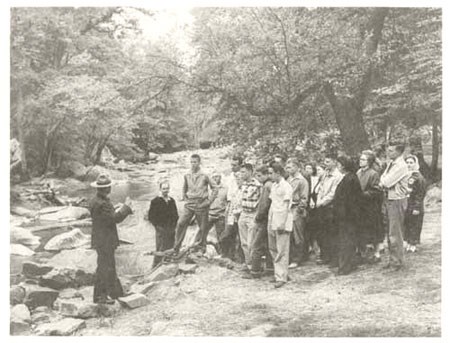|
The Mouth of the Creek With all that was done to preserve and enhance the natural quality of its valley, Rock Creek remained a blighted spectacle at its mouth--a point of great potential attractiveness, as Frederick Law Olmsted, Jr., had observed in 1925 (page 63). The National Park Service acquired possession of the mole at the creek's juncture with the Potomac, but the land just west of the mole and along the west bank of the creek below K Street remained in industrial use. In 1956 the Service initiated planning for a water sports facility on the mole as part of its MISSION 66 development program. Architect William Haussmann visited boathouses at the U.S. Naval Academy, Philadelphia, Princeton, and Syracuse in preparing the design. His plan included restoration of the Chesapeake and Ohio Canal dam at the creek mouth and its tidelock across the tip of the mole. The total cost was estimated at $521,500. [77] The fact that interceptor sewers discharged into the Potomac nearby caused some concern within the Service. Associate Superintendent Harry T. Thompson pressed strongly for the development, contending that pollution was less there than downriver and that the District of Columbia was planning corrective measures. He prevailed, and the Service publicly announced its plans for a scaled-down facility, minus the dam and tide-lock restoration, in January 1958. [78] David V. Auld, the District's director of sanitary engineering, again raised the pollution issue, and John Nolen, Jr., retired staff director of the National Capital Planning Commission, recalled Olmsted's desire to keep the view at the creek mouth open. Nolen favored moving the boat center upriver to the mouth of Foundry Branch, above Georgetown. Haussmann agreed that the Foundry Branch site was "certainly preferable from the esthetic point of view," but vehicular access to it was difficult. Controversy continued into the following year, with District public health authorities and the Washington Post opposing the mole location on health grounds. [79] In March 1959 Harry Thompson, then superintendent, made a final plea for the mole site. Director Wirth informed Secretary of the Interior Fred A. Seaton of the Service's plans to proceed at that location, and in July Seaton finally concurred. On September 22 a $92,289 contract for a parking lot and approach road and bridge over Rock Creek was awarded to Allied Contractors, Inc., followed two months later by a $196,272 award to James L. Partello, Inc., for the boathouse. [80] 117 The National Capital Water Sports Center, as the completed facility was initially known, was dedicated September 24, 1960. Harry Thompson gave the welcoming address at the ceremony. Five months later Thompson died, and on March 22, 1961, Wirth recommended to Secretary Stewart Udall that the center be named the Harry T. Thompson Boat Center. Udall quickly approved the honor for the man who had labored so actively on its behalf. [81] The boat center, renting canoes and other small craft under concession contract and housing racing shells for area schools and colleges, brought public recreational use to the mouth of Rock Creek. [82] In doing so, it rendered even less appealing the railroad tracks and grimy industrial infrastructure along the creek and riverfront next door. By the early 1980s the redevelopment of lower Georgetown (below M Street) was well underway, and the owners of the privately held waterfront land between the creek and 31st Street were planning an elaborate complex of residential condominiums, offices, and a hotel. The block directly adjoining the creek and the mole was encumbered by a 20-foot building height covenant, the result of a 1941 transaction between the government and the Baltimore and Ohio Railroad, its owner at the time. The present owner and developer, seeking to build a luxury hotel and an office building on the block, wanted relief from the height restriction. In exchange, it was willing to grant benefits of equal economic value to the National Park Service, which held the covenant for the government. Under the agreement reached by the parties in 1984 the two buildings would rise to between 50 and 60 feet but would be set well back from the creek and riverfront. The developer would grant perpetual public access along the river and creek and pay for stabilization and landscaping of both creek banks and restoration of the canal tidelock. The agreement came under fire from some local citizens who opposed all private development along the Georgetown waterfront. Supporters of the agreement countered that development was inevitable, in the absence of major appropriations to buy the private land; that the kind of development planned next to the creek was the best that could be expected there and certainly better than the status quo; and that the exchange granting increased public access and parkland improvements was "very much in the public interest," in the words of Regional Director Jack Fish. [83] The opponents sued to block the agreement, and on May 30t 1985, U.S. District Court Judge Barrington D. Parker ruled that the Park Service had illegally alienated National Park System property by easing the terms of the covenant protecting the Rock Creek and Potomac Parkway. If allowed to stand, the decision would stall the planned enhancement of Rock Creek's mouth. At this writing the developer and the Service had filed an appeal. Although the outcome could not be predicted with certainty, there were high hopes that Olmsted's vision of an attractive confluence might yet be realized by the centennial of Rock Creek Park in 1990. [84] 
|
Last updated: April 10, 2015
